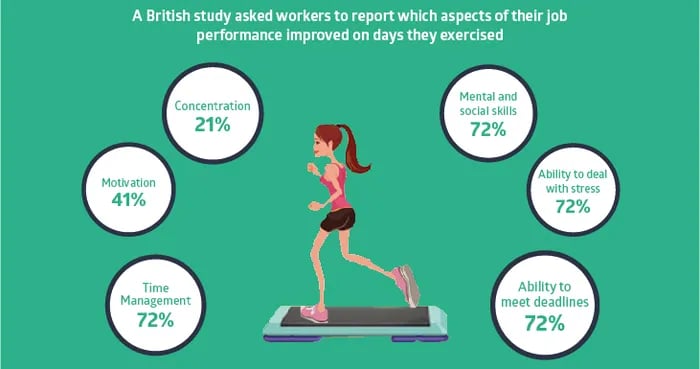7 Ways to Increase Employee Motivation in the Workplace

Employee motivation determines the outcome of an employee’s work performance, engagement, and well-being. It’s your job as the employer to make sure your employees are motivated and engaged. Here we talk about 7 ways in which you can increase and stimulate engagement, inspire your workforce and contribute to their overall health and well-being while boosting productivity levels and bottom line.
Here’s a portrait of a potential employee: his name is John, and he works for your company. Right now, he is busy making a paper airplane. Earlier in the day, he tried to close a sale with a reluctant potential customer, but they had a few too many questions, and John didn’t put in the work, so that fell through. Now, it’s 3 pm, and John is satisfied with his paper airplane. He’ll give it another hour at his desk, checking Facebook and deleting emails he doesn’t feel like responding to, and then he’ll make up an emergency and leave early. He’s doing it more and more these days: no one seems to notice, he’s not getting into any trouble, and he’s getting his check on time every month. So, why not?
Now, if your company has at least 13 employees, there’s bound to be a John somewhere in there. And that’s not a random number: a Gallup report shows that, on average, only 13% of employees state that they feel engaged and motivated at work.
The question is: what are you doing to address the issue of employee motivation in the workplace?
Employee motivation in the workplace largely depends on the overall “health” of relationships in an organization. The managers need to put in an extraordinary effort to get employees excited about their work and maintain that excitement high day in and day out.
What is employee motivation?
Gareth Jones, the definitive expert on the subject, defines employee motivation as:
“psychological forces that determine the direction of a person's behavior in an organization, a person's level of effort and a person's level of persistence.”
There are two different kinds of motivation:
- Extrinsic motivation. It comes from the outside world and typical examples include salary, benefits, company car, a promotion, corporate discounts, and so on.
- Intrinsic motivation. It comes from within and it’s driven by the employee’s desire to impress a manager, learn a new skill, gain more knowledge, impact the company, and similar.
A lot was written on employee motivation so we won’t discuss the differences between the two types. The most important takeaway for managers is that the focus should always be on intrinsic motivation: meaningful work gets done when employees are motivated from within, while extrinsic motivators can even curb creativity and lead to poorer work outcomes.
By impacting employee engagement so profoundly, motivation in your company also has a serious impact on your bottom line. Gallup’s “State of the American Workplace” report found that unmotivated and unhappy workers cost the American economy between $450 and $500 billion every year! That’s a mind-boggling amount of money, and you want to make sure your organization is not contributing to it at all!
Make employee engagement your priority
Try Ambassify now7 strategies to increase employee motivation in the workplace
We’d love to say that these practical tips for increasing employee motivation are simple and easy. Unfortunately, they are not. They will require top management buy-in and an overhaul of established HR processes in more traditional companies.
However, the benefits you will reap with just a few changes in the way you manage your employees are definitely worth a few minor inconveniences, and, in the end, you will be glad you put employee motivation front and center!
1. Transform your managers into leaders

True leaders are inspiring — they help others achieve their goals, hold themselves to a higher standard, and lead by example. They also very rarely grow in the wild. What we meant by that is that leadership can be learned to an extent, and investing in that education is the smartest way for an organization to spend its money.
A lot of the advice on this list hinges on your managers’ ability to execute flawlessly — knowing when to be lenient, when to apply pressure, when to recognize outstanding work, and how to praise employees and get them to press on even harder. Make sure to hire and promote the right people when it comes to managerial positions because managers will be the ones who dictate the overall motivation of employees who report to them.
2. Recognize great work
Would you put in extra work if you felt that it went unrecognized? It’s hardly motivating, right? Recognition and praise are vastly underrated, despite being one of the most potent tools at a manager’s disposal.
One employee’s idea secured a new client? Another one’s side project decreased onboarding time? The third one’s cleared a roadblock on a particular project? A good leader will shine a spotlight on all of these employees and make sure that everyone in the organization gets an email with their names featured in it in bold print — in addition to signing their bonus check!
3. Set and celebrate measurable goals
Working on a project that drags on and on is detrimental to employee motivation. If most of the tasks your employees work on are labor-intensive and time-consuming, ensure that innovative goal-setting practices are in full effect.
Empower your managers to discuss individual projects with their teams and encourage them to propose incremental and measurable goals. After each milestone is completed, celebrate it! It gives employees a slight sense of accomplishment, and they feel that they are that much closer to the overall goal, which boosts their determination going forward.
4. Give their work a purpose
Employees know that their work contributes to the company’s bottom line. Most of the time, however, they don’t see how that happens exactly. That can be slightly demotivating.
It’s your job to communicate that impact to employees. For example, you could communicate to your customer support team how much their retention efforts and the resulting reduction in customer churn saved the company in a specific month. Or tell your sales team how much their increase in sales contributed to the bottom line.
Additionally, you can also focus on how your employees’ work impacts your ability to change the world. If you contribute to specific causes, tell your employees about it.
Turn your employees into sustainability ambassadors
Check out our use case5. Encourage organizational transparency and trust
Generally, when employees see the big picture and know where they fit in it, they feel more motivated and perform better. For this to happen, though, you need to practice organizational transparency. It just means being open and honest — from the top down and sideways — about the company’s goals, practices, expenditures, investments, and overall mission. This level of transparency fosters trust more than anything else that you could do.
Organizational transparency also reduces employee errors. When everyone is working with the same set of information, it’s easier to perform effectively. This change needs to come from the top, though — executive managers need to ensure that communication lines are open and that everyone in the company is on the same page.
6. Fit and healthy employees are motivated employees
If you want your employees motivated and performing to the best of their abilities, make sure they are healthy, rested, fit, and fueled up.
When it comes to health, you should have policies in place that encourage sick employees to take time off. They need it to heal anyway, and they are not helpful to you if they are barely keeping their head up. The cost that you will incur with them being off is still a lot lower than what you will deal with if they continue performing poorly or, worse yet, come in and get everyone else sick, too.

To curb the potential for burnout, look into creating a rec or a break room where employees can unwind when they feel stressed out. Coffee and snack availability is generally considered a perk. Still, it’s also been shown that hungry employees are less productive, so you’re feeding your people more for your benefit than theirs!
7. Promote self-governance
Being able to decide for yourself how and when you work is a great motivator. On the other hand, being a stickler for the rules can put a real damper on employee motivation.
Trust your employees to do the work you hired them to do. Give them a deadline, support their work, and watch them deliver for you. Do they do their best work early in the morning while sitting at their home office desk in their jammies? Count that as work hours.
They are most productive during weekends and come in on Monday with half of their weekly work already done? Count that as well. Train your managers to avoid micromanagement in this particular aspect of work, and you will notice everyone’s productivity soaring.
These are by no means the only things that you can do to increase employee motivation in the workplace. However, these suggestions yield the greatest gains. Additionally, you should strive toward making the work environment fun, gamifying work-related experiences, instituting an open-door policy, and more. Don’t be afraid to modify these employee motivation strategies to fit your bill — after all, every organization is different.
So, yeah, inspiring and motivating your employees at work can be challenging and sometimes somewhat of an investment. Still, the results it will yield are long-term and beneficial for both your business and the health and well-being of your employees.
So the best thing you can do right now is implement these 7 simple strategies to boost motivation and soon reap the benefits of your new policies and mindset!